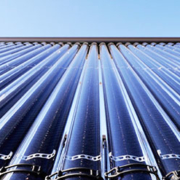This website uses cookies so that we can provide you with the best user experience possible. Cookie information is stored in your browser and performs functions such as recognising you when you return to our website and helping our team to understand which sections of the website you find most interesting and useful.
Solar Thermal
A smart combination: cooling with the power of the sun

Solar thermal systems are not only suitable for heating or for heating domestic hot water: Combined with an adsorption system, solar heat can also be used for cooling. This pays off especially in summer. This is because solar thermal systems are designed for the transitional periods. Consequently, they produce excess heat in the summer months. At the same time, it is precisely during the hot season that there is the greatest need for air conditioning.
FAHRENHEIT adsorption units convert this excess heat energy into cooling energy. This is not only particularly economical and environmentally friendly: the systems are also better utilized – and protected from overheating or overloading. Last but not least, this also increases their service life.
Combined heat and power plants (CHP)
Combined heat, power and cooling: Making optimum use of energy.
 Combined heat and power plants (CHP) operate on the principle of cogeneration. As a result, they use the energy input much more efficiently than would be possible with the conventional, separate supply of electricity and heat. However, many CHP operators wonder what to do with the heat generated in the summer. The ideal answer here is the additional integration of an adsorption refrigeration system. This is because the conversion of surplus heat into cold – e.g. for air conditioning – ensures optimum utilization of the system throughout the year – and can thus improve its profitability. Intelligent control is crucial here. It helps to optimize the overall system by flexibly coordinating the generation of heat, electricity and cooling.
Combined heat and power plants (CHP) operate on the principle of cogeneration. As a result, they use the energy input much more efficiently than would be possible with the conventional, separate supply of electricity and heat. However, many CHP operators wonder what to do with the heat generated in the summer. The ideal answer here is the additional integration of an adsorption refrigeration system. This is because the conversion of surplus heat into cold – e.g. for air conditioning – ensures optimum utilization of the system throughout the year – and can thus improve its profitability. Intelligent control is crucial here. It helps to optimize the overall system by flexibly coordinating the generation of heat, electricity and cooling.
Compressed air
Cooling with waste heat from compressed air

Almost all manufacturing companies have compressed air networks. At the same time, cooling requirements for both manufacturing and buildings are constantly increasing and driving energy demand. Adsorption cooling offers an ideal approach for this, generating cooling through heat recovery and reducing energy costs.
More than three-quarters of the electrical power that goes into air compressors can be recovered as hot water. Fittingly, the temperature range of hot water from compressed air systems is exactly within the optimal operating range of adsorption chillers. This makes the combination of the two an ideal way to increase energy efficiency whenever cooling is needed, whether for process cooling or for room temperature control.
Process Waste Heat
Powerful cooling from unused waste heat

Industry and commerce need artificially generated cooling – and this demand is growing steadily. At the same time, electricity prices continue to rise. Increasingly stringent climate protection targets – and the regulations that go with them – also make it necessary to design plant technology that is energy-efficient and environmentally friendly. Many companies are faced with challenges that can hardly be met with conventional solutions.
Adsorption refrigeration opens up new, very economical perspectives here. This is because it uses previously unused waste heat to intelligently cool processes and buildings. The result: significantly lower electricity costs – and a valuable contribution to climate protection. Because FAHRENHEIT systems not only cool very economically: they also reduce CO₂ emissions and work exclusively with environmentally compatible materials.